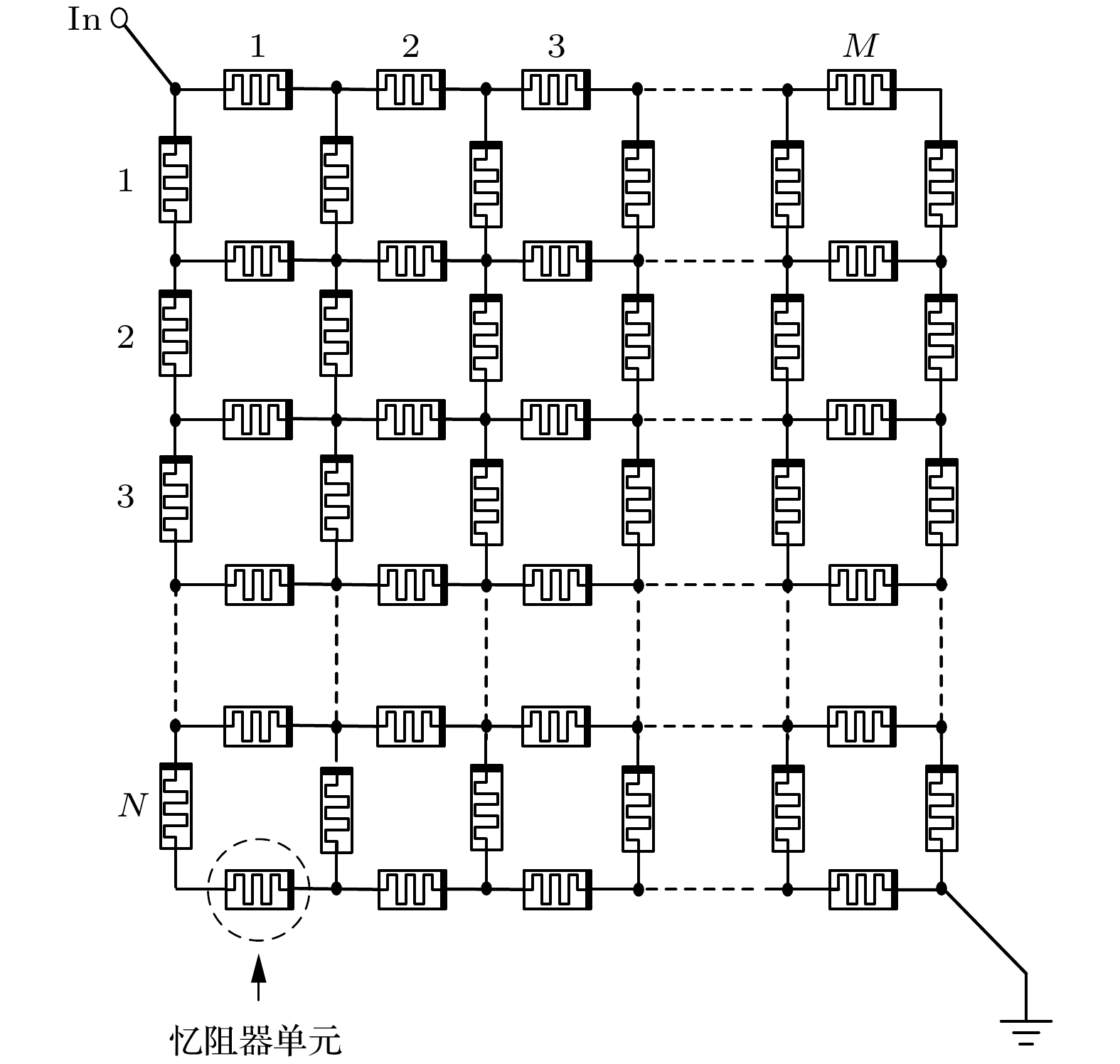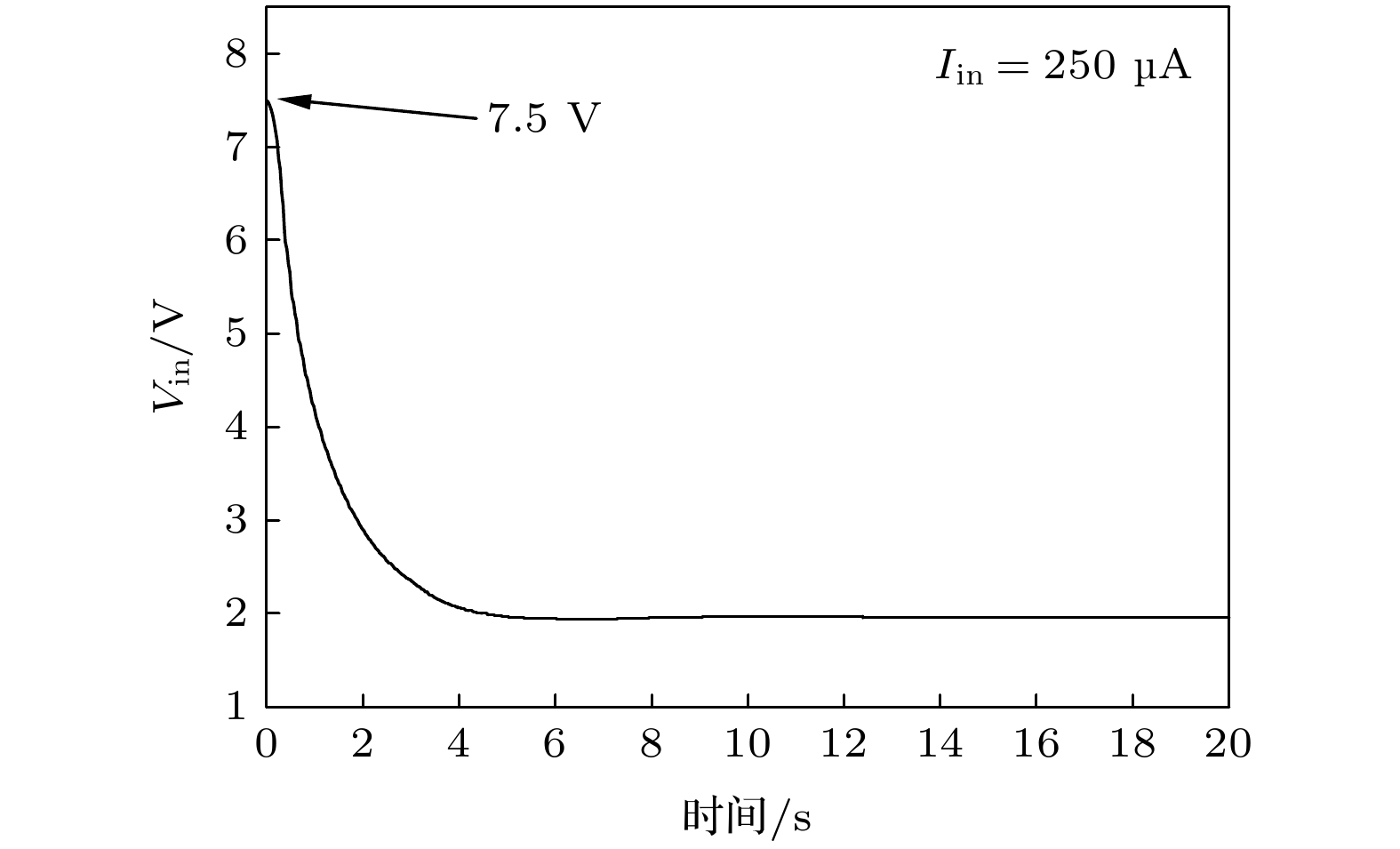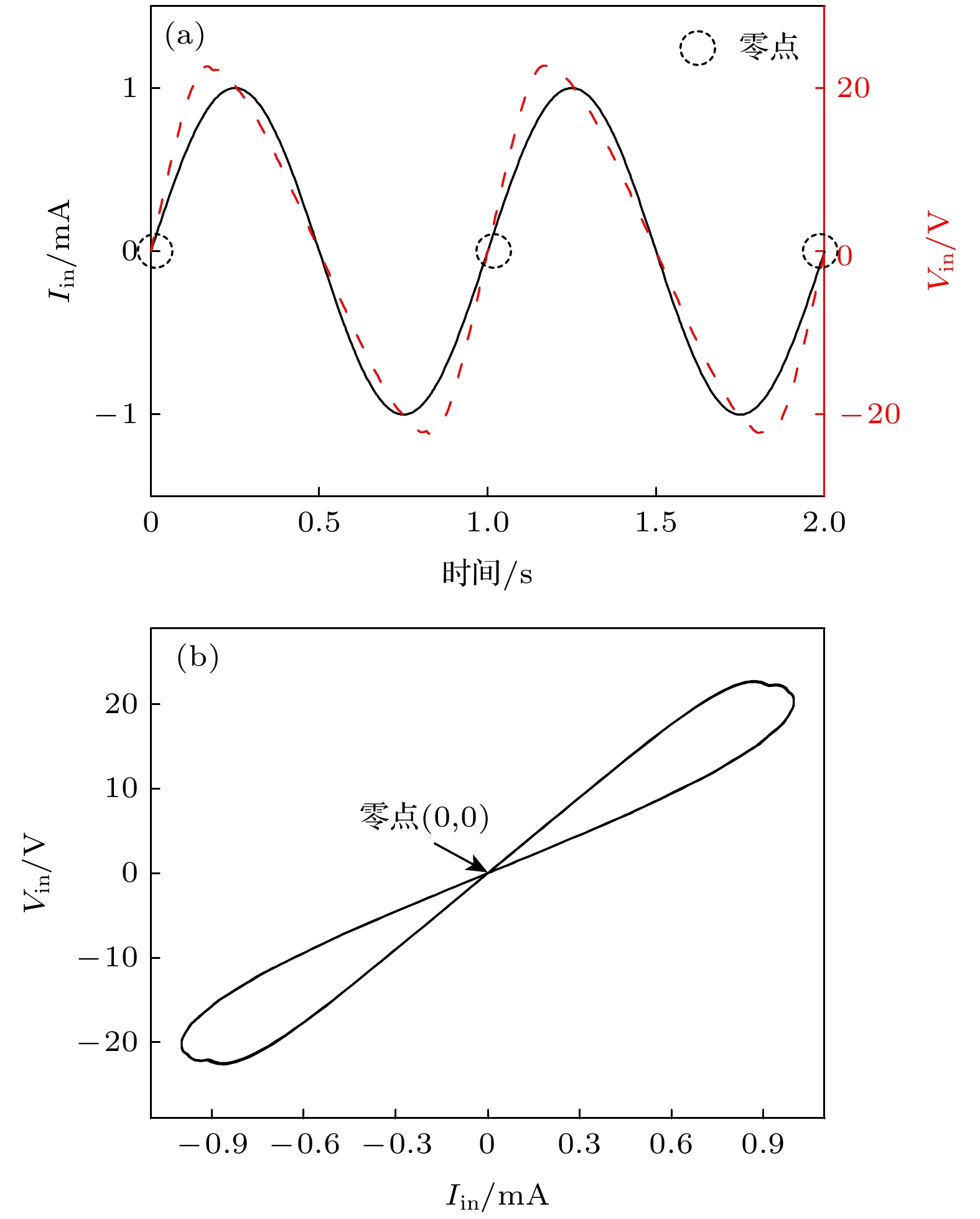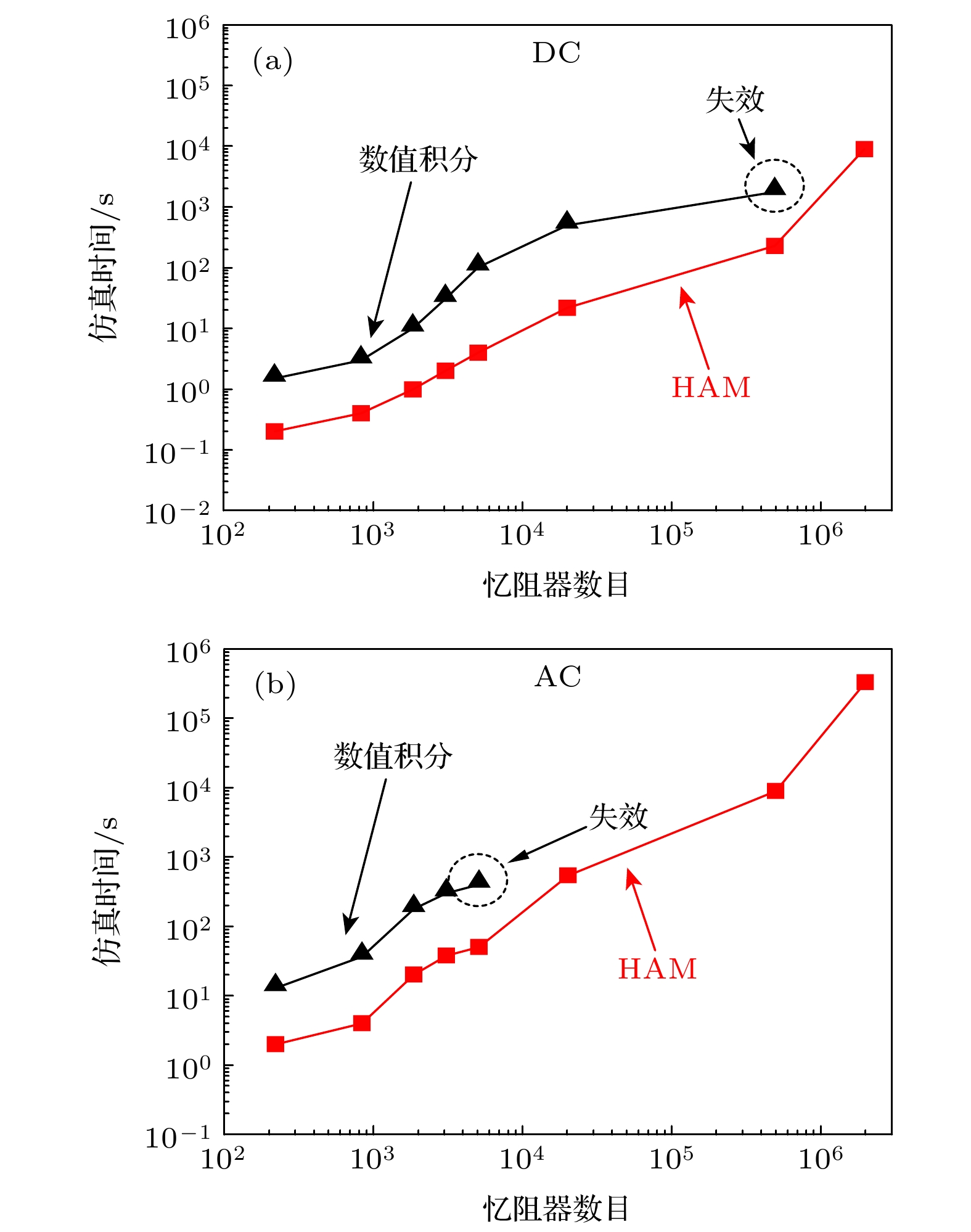-
Memristive networks are large-scale non-linear circuits based on memristor cells, playing a crucial role in developing the emerging researches such as next-generation artificial intelligence, bioelectronics, and high-performance memory. The performance of memristive networks is greatly affected by the memristor model describing physical and electrical characteristics of a memristor cell. However, existing models are mainly non-analytic and, accordingly, may have convergence issues in their applications in memristive networks’ analyses. Therefore, aiming at improving convergence of memristive networks, we propose an analytic modeling strategy for memristor based on homotopy analysis method (HAM). In this strategy, the HAM is used to obtain an analytic memristor model through solving the state equations of memristors in original physical model. Specifically, the HAM is used to solve the analytic approximate solution of the core parameter of memristor—state variable, from the state equations, in the form of analytic homotopy series. Then the analytic approximate model of memristor is obtained by using the solved state variables. The characteristics of the proposed strategy are as follows. 1) Its solution has a closed-form expression, i.e. an explicit function, 2) its approximation error is optimized, thereby realizing the convergence optimization. Moreover, according to the characteristics of memristive networks, we introduce an analysis criterion for memristor model applicable to memristive networks. Through the long-time evolution experiments of a memristor cell and a benchmark memristive matrix network with different inputs, and the comparisons with the traditional non-analytic (numeric) method, we verify the analyticity and convergence superiority of the modeling strategy. Besides, based on this strategy and the comparison experiments, we reveal that one of the underlying reasons for non-convergence in the large-scale memristive network simulation possesses the non-analyticity of the used memristor model. The strategy can be further used for analyzing the performances of a memristor cell and memristive networks in long-time. It also has potential applications in emerging technologies.
-
Keywords:
- memristor /
- memristive networks /
- homotopy analysis method (HAM) /
- analytic modeling strategy
[1] Strukov D B, Snider G S, Stewart D R, Williams R S 2008 Nature 453 80
 Google Scholar
Google Scholar
[2] 邵楠, 张盛兵, 邵舒渊 2019 物理学报 68 282
Shao N, Zhang S B, Shao S Y 2019 Acta Phys. Sin. 68 282
[3] Wang S P, He C L, Tang J, Yang R, Shi D X, Zhang G Y 2019 Chin. Phys. B 28 017304
 Google Scholar
Google Scholar
[4] 余志强, 刘敏丽, 郎建勋, 钱楷, 张昌华 2018 物理学报 67 157302
 Google Scholar
Google Scholar
Yu Z Q, Liu M L, Lang J X, Qian K, Zhang C H 2018 Acta Phys. Sin. 67 157302
 Google Scholar
Google Scholar
[5] Bafrani H A, Ebrahimi M, Shouraki S B, Moshfegh A Z 2018 Nanotechnology 29 15205
 Google Scholar
Google Scholar
[6] Choi B J, Torrezan A C, Strachan J P, Kotula P G, Lohn A J, Marinella M J, Li Z Y, Williams R S, Yang J J 2016 Adv. Funct. Mater. 26 5290
 Google Scholar
Google Scholar
[7] Simanjuntak F M, Chandrasekaran S, Lin C C, Tseng T Y 2019 APL Mater. 7 051108
 Google Scholar
Google Scholar
[8] 陈义豪, 徐威, 王钰琪, 万相, 李岳峰, 梁定康, 陆立群, 刘鑫伟, 连晓娟, 胡二涛, 郭宇锋, 许剑光, 童祎, 肖建 2019 物理学报 68 098501
 Google Scholar
Google Scholar
Chen Y H, Xu W, Wang Y Q, Wan X, Li Y F, Liang D K, Lu L Q, Liu X W, Lian X J, Hu Er T, Guo Y F, Xu J G, Tong Y, Xiao J 2019 Acta Phys. Sin. 68 098501
 Google Scholar
Google Scholar
[9] Banerjee W, Zhang X M, Luo Q, Lv H B, Liu Q, Long S B, Liu M 2017 Adv. Electron. Mater. 4 1700561
[10] Li C, Belkin D, Li Y N, Yan P, Hu M, Ge N, Jiang H, Montgomery E, Lin P, Wang Z R, Song W H, Strachan J P, Barnell M, Wu Q, Williams R S, Yang J J, Xia Q F 2018 Nat. Commun. 9 2385
 Google Scholar
Google Scholar
[11] Sung S H, Kim D H, Kim T J, Kang I S, Lee K J 2019 Adv. Mater. Technol. 4 1900080
 Google Scholar
Google Scholar
[12] 徐威, 王钰琪, 李岳峰, 高斐, 张缪城, 连晓娟, 万相, 肖建, 童祎 2019 物理学报 68 238501
 Google Scholar
Google Scholar
Xu W, Wang Y Q, Li Y F, Gao F, Zhang M C, Lian X J, Wan X, Xiao J, Tong Y 2019 Acta Phys. Sin. 68 238501
 Google Scholar
Google Scholar
[13] Hu X F, Feng G, Duan S K, Liu L 2017 IEEE Trans. Neural Networks Learn. Syst. 28 1889
 Google Scholar
Google Scholar
[14] Schmitt R, Kubicek M, Sediva E, Trassin M, Weber M C, Rossi A, Hutter H, Kreisel J, Fiebig M, Rupp J L M 2018 Adv. Funct. Mater. 29 1804782
[15] Luo Q, Zhang X M, Hu Y, Gong T C, Xu X X, Yuan P, Ma H, Dong D N, Lv H B, Long S B, Liu Q, Liu M 2018 IEEE Electron Device Lett. 39 664
 Google Scholar
Google Scholar
[16] Xue W H, Ci W J, Xu X H, Liu G 2020 Chin. Phys. B 29 048401
 Google Scholar
Google Scholar
[17] 朱玮, 郭恬恬, 刘兰, 周荣荣 2021 物理学报 70 068502
 Google Scholar
Google Scholar
Zhu W, Guo T T, Liu L, Zhou R R 2021 Acta Phys. Sin. 70 068502
 Google Scholar
Google Scholar
[18] Duan S K, Hu X F, Dong Z K, Wang L D, Mazumder P 2015 IEEE Trans. Neural Networks Learn. Syst. 26 1202
 Google Scholar
Google Scholar
[19] Mladenov V 2019 Electronics 8 383
 Google Scholar
Google Scholar
[20] Biolek D, Kolka Z, Biolková V, Biolek Z, Potrebić M, Tošić D 2018 Int. J. Circuit Theory Appl. 46 50
 Google Scholar
Google Scholar
[21] Li C, Han L L, Jiang H, Jang M H, Lin P, Wu Q, Barnell M, Yang J J, Xin L H, Xia Q F 2017 Nat. Commun. 8 15666
 Google Scholar
Google Scholar
[22] Yakopcic C, Taha T M, Subramanyam G, Robinson E P 2013 IEEE Trans. Comput-Aided Des. Integr. Circuits Syst. 32 1201
 Google Scholar
Google Scholar
[23] Li H, Huang P, Gao B 2014 IEEE Electron Device Lett. 35 211
 Google Scholar
Google Scholar
[24] 廖世俊 1992 博士学位论文 (上海: 上海交通大学)
Liao S J 1992 Ph. D. Dissertation (Shanghai: Shanghai Jiaotong University) (in Chinese)
[25] Abbasbandy S, Zakaria F S 2008 Nonlinear Dyn. 51 83
[26] Ellahi R, Raza M, Vafai K 2012 Math. Comput. Model. 55 1876
 Google Scholar
Google Scholar
[27] Li X C, Yu Z Y, Liao J S 2015 Phys. Rev. E 92 033014
 Google Scholar
Google Scholar
[28] Biolek D, Biolek Z, Biolkova V, Kolka Z 2014 Semicond. Sci. Technol. 29 125008
 Google Scholar
Google Scholar
[29] Joglekar Y N, Wolf S J 2009 Eur. J. Phys. 30 661
 Google Scholar
Google Scholar
[30] Biolek Z, Biolek D, Biolkova V 2009 Radioengineering 18 210
[31] Prodromakis T, Peh B P, Papavassiliou C, Toumazou C 2011 IEEE Trans. Electron Devices 58 3099
 Google Scholar
Google Scholar
[32] https://www.wolfram.com/ [2020-11-21]
[33] https://www.synopsys.com/ [2020-12-28]
[34] Biolek D, Biolek Z, Biolkova V, KOLKA Z 2015 Radioengineering 24 393
 Google Scholar
Google Scholar
[35] Zhang Y, Wang X P, Li Y, Friedman E G 2017 IEEE Trans. Circuits Syst. Express Briefs 64 767
 Google Scholar
Google Scholar
[36] Chua L O 2015 Radioengineering 24 319
 Google Scholar
Google Scholar
[37] Adhikari S P, Sah M P, Kim H, Chua L O 2013 IEEE Trans. Circuits Syst. Regul. Pap. 60 3008
 Google Scholar
Google Scholar
[38] Cserti J 2000 Am. J. Phys. 68 896
 Google Scholar
Google Scholar
[39] Carbajal J P, Dambre J, Hermans M, Schrauwen B 2015 Neural Comput. 27 725
 Google Scholar
Google Scholar
[40] Hatem F O, Kumar T N, Almurib H A F 2016 IEEE Trans. Circuits Syst. Regul. Pap. 63 1487
 Google Scholar
Google Scholar
[41] Chang T, Jo S H, Kim K H, Sheridan P, Gaba S, Lu W 2011 Appl. Phys. A 102 857
 Google Scholar
Google Scholar
[42] Amirsoleimani A, Shamsi J, Ahmadi M, Ahmadi A, Alirezaee A, Mohammadi K, Karami M A, Yakopcic C, Kavehei O, Al-Sarawi S 2017 Microelectron. J. 65 49
 Google Scholar
Google Scholar
-
图 1 输入电流
$ A{\rm sin}\left(\omega t\right) $ 激励下, HP Pt/TiO2/Pt忆阻器单元的传统非解析和HAM解析模型中各自状态变量$ x\left(t\right) $ 的长时演化对比 (a)非解析(数值积分)模型[35]; (b)解析的HAM模型. 两种模型采用相同的仿真配置(Hspice仿真)和器件参数: 优化型Prodromakis窗函数[31,34] ($f\left(x\right)= $ $ [ 1-{\left({x}^{ 2}-x+ 1\right)}^{P}]/(1-{0.75}^{P})$ ), 其中非线性控制参数$ P=7 $ ),$ {x}_{0}=0.5, {R}_{{\rm O}{\rm N}}=1 $ 00 Ω,$ \delta =10 $ (高低忆阻值之比),$ A=1 $ mA, 以及$ \omega =0.1/\left(2\pi \right) $ rad/sFigure 1. Dynamic evolution comparison of the state variables based on the traditional non-analytic[35] and the analytic HAM models of the HP Pt/TiO2/Pt memristor, respectively, under an input current
$ A{\rm sin}\left(\omega t\right) $ : (a) Non-analytic (numeric integration) mode; (b) analytic 3-order HAM model. The optimized Prodromakis window[31,34] ($f\left(x\right)= $ $ [ 1-{\left({x}^{ 2}-x+ 1\right)}^{P}]/(1-{0.75}^{P})$ ), where nonlinearity controlling parameter$ P=7 $ ) and the device parameters:$ {x}_{0}=0.5, {R}_{{\rm O}{\rm N}}=1 $ 00 Ω,$ \delta =10 $ (the ratio of high memristance to low resistance), A = 1 mA, and$ \omega =0.1/\left(2\pi \right) $ rad/s, are used in the two models (Hspice simulation).图 3 250
$ {\text{μ}}$ A DC电流Iin输入下, 忆阻矩阵网络中“in”输入端电压Vin的瞬态长时演化$ M=50 $ ,$ N=30 $ . 除采用Biolek窗函数[30]($ P=2 $ )、初始忆阻值${R}_{0}=16.6\;{\rm k}{ \Omega }$ ,$ \delta =1000 $ 之外, 其余仿真参数均与图1相同Figure 3. Transient long-time evolution of the “in” terminal voltage (Vin) of the matrix network under a 250
${\text{μ}}$ A DC current input (Iin).$ M=50 $ ,$ N=30 $ , and the simulation parameters are the same as those in Fig. 1 except the Biolek window[30] ($ P=2 $ ), initial memristance$ {R}_{0}=1 $ 6.6 kΩ, and$ \delta =1000 $ are used.图 4 输入幅度为1 mA、频率为1 Hz的AC(正弦)电流时所对应的忆阻矩阵瞬态长时演化 (a) 忆阻矩阵网络中“in”输入端电压Vin; (b) 相应的I-V曲线(重叠压缩迟滞环). 各仿真参数均与图3相同
Figure 4. Transient long-time evolutions of memristive matrix network under a 1 mA, 1 Hz AC (Sinusoidal) current input: (a) “in” voltage Vin; (b) corresponding I-V curves (compressed hysteresis loops). The simulation parameters are the same as those in Fig. 3.
图 5 分别采用HAM和传统非解析[37](数值积分)模型进行忆阻矩阵仿真, 随着忆阻器单元数目的增加, 仿真时间的对比 (a)和(b)分别表示DC和AC (正弦)电流输入下的仿真时间. 此对比分析基于图3(DC)和图4(AC)所示Vin的动态演化
Figure 5. Comparisons of running time between simulations using the HAM and the traditional non-analytic (numeric integration)[35] and models with increasing memristor cells: (a) and (b) show the time under the DC and AC (Sinusoidal) current inputs, respectively. The comparisons are adopted to analyze the dynamic evolutions Vin as shown in Figs. 3 (DC) and 4 (AC).
表 1 直流演化场景下, 基于不同类型忆阻器单元的忆阻网络仿真时长比较
Table 1. Running time comparisons of the DC evolution for memristive networks with different types of memristor cells.
M = N Pt/Ta2O5/TaOx/Pt忆阻器单元[40] Pd/WO3/W忆阻器单元[41] Ag/TiO2/ITO忆阻器单元[42] 传统非解析模型/s HAM模型/s 传统非解析模型/s HAM模型/s 传统非解析模型/s HAM模型/s 10 0.30 0.01 0.53 0.02 1.12 0.10 50 49 4 71 6 不收敛 7 100 173 12 不收敛 15 不收敛 20 *注: 忆阻网络的仿真设置与图3和图5(a)相同. 由于该表主要目的为通过仿真时长对比来验证HAM模型相对于非解析模型的扩展性优势, 且上述忆阻器硬件无法商业获取, 该表并未列出基于上述忆阻器网络的硬件运行时间, 也从应用的角度体现了模型和建模策略的重要性. -
[1] Strukov D B, Snider G S, Stewart D R, Williams R S 2008 Nature 453 80
 Google Scholar
Google Scholar
[2] 邵楠, 张盛兵, 邵舒渊 2019 物理学报 68 282
Shao N, Zhang S B, Shao S Y 2019 Acta Phys. Sin. 68 282
[3] Wang S P, He C L, Tang J, Yang R, Shi D X, Zhang G Y 2019 Chin. Phys. B 28 017304
 Google Scholar
Google Scholar
[4] 余志强, 刘敏丽, 郎建勋, 钱楷, 张昌华 2018 物理学报 67 157302
 Google Scholar
Google Scholar
Yu Z Q, Liu M L, Lang J X, Qian K, Zhang C H 2018 Acta Phys. Sin. 67 157302
 Google Scholar
Google Scholar
[5] Bafrani H A, Ebrahimi M, Shouraki S B, Moshfegh A Z 2018 Nanotechnology 29 15205
 Google Scholar
Google Scholar
[6] Choi B J, Torrezan A C, Strachan J P, Kotula P G, Lohn A J, Marinella M J, Li Z Y, Williams R S, Yang J J 2016 Adv. Funct. Mater. 26 5290
 Google Scholar
Google Scholar
[7] Simanjuntak F M, Chandrasekaran S, Lin C C, Tseng T Y 2019 APL Mater. 7 051108
 Google Scholar
Google Scholar
[8] 陈义豪, 徐威, 王钰琪, 万相, 李岳峰, 梁定康, 陆立群, 刘鑫伟, 连晓娟, 胡二涛, 郭宇锋, 许剑光, 童祎, 肖建 2019 物理学报 68 098501
 Google Scholar
Google Scholar
Chen Y H, Xu W, Wang Y Q, Wan X, Li Y F, Liang D K, Lu L Q, Liu X W, Lian X J, Hu Er T, Guo Y F, Xu J G, Tong Y, Xiao J 2019 Acta Phys. Sin. 68 098501
 Google Scholar
Google Scholar
[9] Banerjee W, Zhang X M, Luo Q, Lv H B, Liu Q, Long S B, Liu M 2017 Adv. Electron. Mater. 4 1700561
[10] Li C, Belkin D, Li Y N, Yan P, Hu M, Ge N, Jiang H, Montgomery E, Lin P, Wang Z R, Song W H, Strachan J P, Barnell M, Wu Q, Williams R S, Yang J J, Xia Q F 2018 Nat. Commun. 9 2385
 Google Scholar
Google Scholar
[11] Sung S H, Kim D H, Kim T J, Kang I S, Lee K J 2019 Adv. Mater. Technol. 4 1900080
 Google Scholar
Google Scholar
[12] 徐威, 王钰琪, 李岳峰, 高斐, 张缪城, 连晓娟, 万相, 肖建, 童祎 2019 物理学报 68 238501
 Google Scholar
Google Scholar
Xu W, Wang Y Q, Li Y F, Gao F, Zhang M C, Lian X J, Wan X, Xiao J, Tong Y 2019 Acta Phys. Sin. 68 238501
 Google Scholar
Google Scholar
[13] Hu X F, Feng G, Duan S K, Liu L 2017 IEEE Trans. Neural Networks Learn. Syst. 28 1889
 Google Scholar
Google Scholar
[14] Schmitt R, Kubicek M, Sediva E, Trassin M, Weber M C, Rossi A, Hutter H, Kreisel J, Fiebig M, Rupp J L M 2018 Adv. Funct. Mater. 29 1804782
[15] Luo Q, Zhang X M, Hu Y, Gong T C, Xu X X, Yuan P, Ma H, Dong D N, Lv H B, Long S B, Liu Q, Liu M 2018 IEEE Electron Device Lett. 39 664
 Google Scholar
Google Scholar
[16] Xue W H, Ci W J, Xu X H, Liu G 2020 Chin. Phys. B 29 048401
 Google Scholar
Google Scholar
[17] 朱玮, 郭恬恬, 刘兰, 周荣荣 2021 物理学报 70 068502
 Google Scholar
Google Scholar
Zhu W, Guo T T, Liu L, Zhou R R 2021 Acta Phys. Sin. 70 068502
 Google Scholar
Google Scholar
[18] Duan S K, Hu X F, Dong Z K, Wang L D, Mazumder P 2015 IEEE Trans. Neural Networks Learn. Syst. 26 1202
 Google Scholar
Google Scholar
[19] Mladenov V 2019 Electronics 8 383
 Google Scholar
Google Scholar
[20] Biolek D, Kolka Z, Biolková V, Biolek Z, Potrebić M, Tošić D 2018 Int. J. Circuit Theory Appl. 46 50
 Google Scholar
Google Scholar
[21] Li C, Han L L, Jiang H, Jang M H, Lin P, Wu Q, Barnell M, Yang J J, Xin L H, Xia Q F 2017 Nat. Commun. 8 15666
 Google Scholar
Google Scholar
[22] Yakopcic C, Taha T M, Subramanyam G, Robinson E P 2013 IEEE Trans. Comput-Aided Des. Integr. Circuits Syst. 32 1201
 Google Scholar
Google Scholar
[23] Li H, Huang P, Gao B 2014 IEEE Electron Device Lett. 35 211
 Google Scholar
Google Scholar
[24] 廖世俊 1992 博士学位论文 (上海: 上海交通大学)
Liao S J 1992 Ph. D. Dissertation (Shanghai: Shanghai Jiaotong University) (in Chinese)
[25] Abbasbandy S, Zakaria F S 2008 Nonlinear Dyn. 51 83
[26] Ellahi R, Raza M, Vafai K 2012 Math. Comput. Model. 55 1876
 Google Scholar
Google Scholar
[27] Li X C, Yu Z Y, Liao J S 2015 Phys. Rev. E 92 033014
 Google Scholar
Google Scholar
[28] Biolek D, Biolek Z, Biolkova V, Kolka Z 2014 Semicond. Sci. Technol. 29 125008
 Google Scholar
Google Scholar
[29] Joglekar Y N, Wolf S J 2009 Eur. J. Phys. 30 661
 Google Scholar
Google Scholar
[30] Biolek Z, Biolek D, Biolkova V 2009 Radioengineering 18 210
[31] Prodromakis T, Peh B P, Papavassiliou C, Toumazou C 2011 IEEE Trans. Electron Devices 58 3099
 Google Scholar
Google Scholar
[32] https://www.wolfram.com/ [2020-11-21]
[33] https://www.synopsys.com/ [2020-12-28]
[34] Biolek D, Biolek Z, Biolkova V, KOLKA Z 2015 Radioengineering 24 393
 Google Scholar
Google Scholar
[35] Zhang Y, Wang X P, Li Y, Friedman E G 2017 IEEE Trans. Circuits Syst. Express Briefs 64 767
 Google Scholar
Google Scholar
[36] Chua L O 2015 Radioengineering 24 319
 Google Scholar
Google Scholar
[37] Adhikari S P, Sah M P, Kim H, Chua L O 2013 IEEE Trans. Circuits Syst. Regul. Pap. 60 3008
 Google Scholar
Google Scholar
[38] Cserti J 2000 Am. J. Phys. 68 896
 Google Scholar
Google Scholar
[39] Carbajal J P, Dambre J, Hermans M, Schrauwen B 2015 Neural Comput. 27 725
 Google Scholar
Google Scholar
[40] Hatem F O, Kumar T N, Almurib H A F 2016 IEEE Trans. Circuits Syst. Regul. Pap. 63 1487
 Google Scholar
Google Scholar
[41] Chang T, Jo S H, Kim K H, Sheridan P, Gaba S, Lu W 2011 Appl. Phys. A 102 857
 Google Scholar
Google Scholar
[42] Amirsoleimani A, Shamsi J, Ahmadi M, Ahmadi A, Alirezaee A, Mohammadi K, Karami M A, Yakopcic C, Kavehei O, Al-Sarawi S 2017 Microelectron. J. 65 49
 Google Scholar
Google Scholar
Catalog
Metrics
- Abstract views: 8074
- PDF Downloads: 89
- Cited By: 0














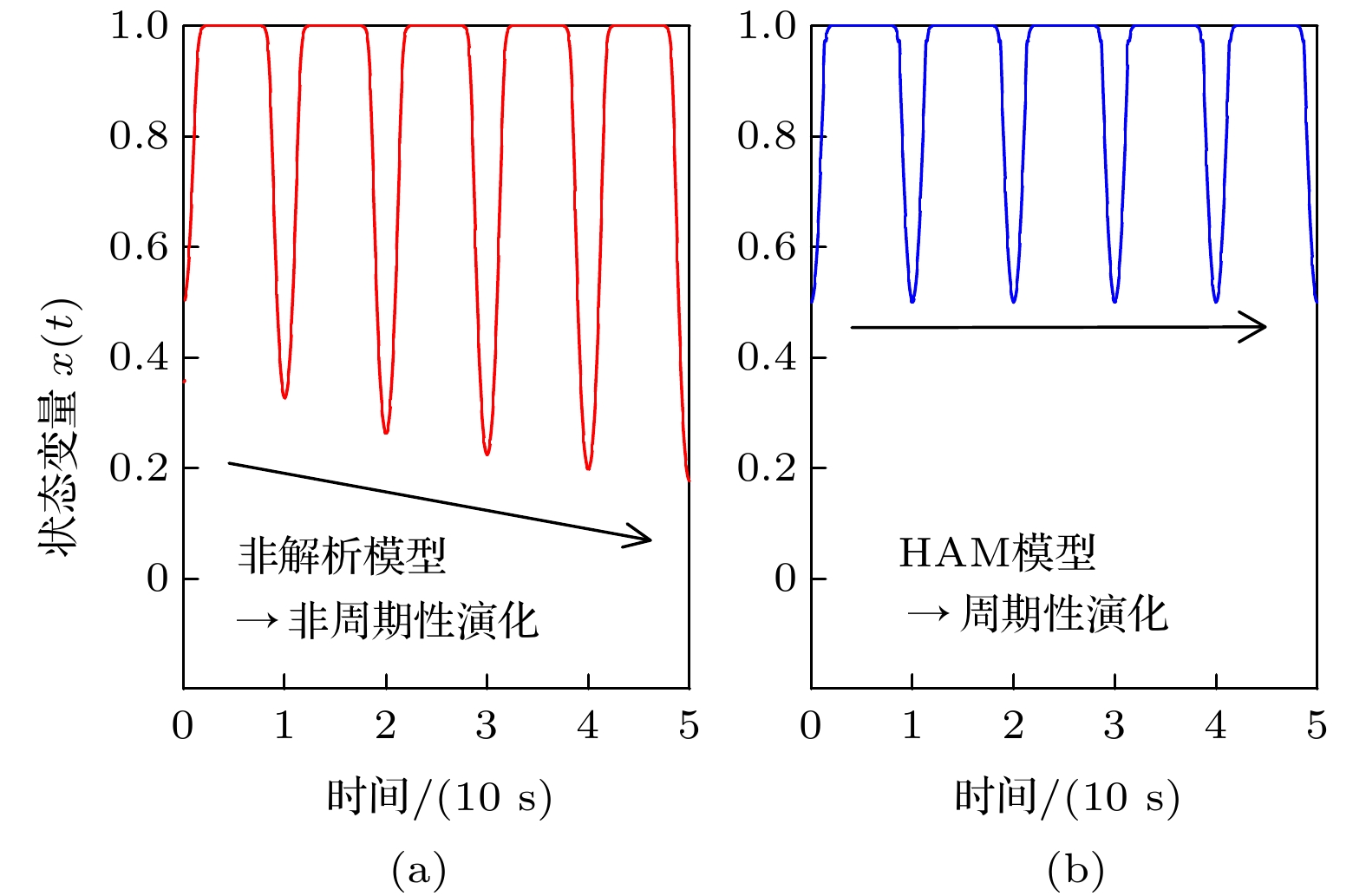
















 DownLoad:
DownLoad:
